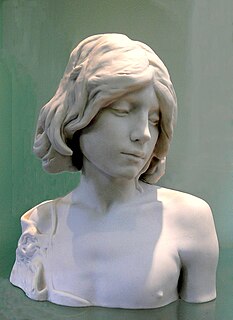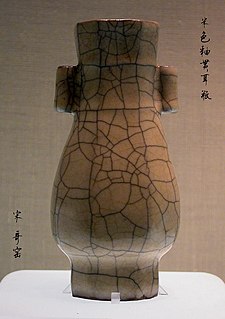
Porcelain is a ceramic material made by heating materials, generally including kaolin, in a kiln to temperatures between 1,200 and 1,400 °C. The toughness, strength, and translucence of porcelain, relative to other types of pottery, arises mainly from vitrification and the formation of the mineral mullite within the body at these high temperatures. Though definitions vary, porcelain can be divided into three main categories: hard-paste, soft-paste and bone china. The category that an object belongs to depends on the composition of the paste used to make the body of the porcelain object and the firing conditions.

Longquan celadon (龍泉青瓷) is a type of green-glazed Chinese ceramic, known in the West as celadon or greenware, produced from about 950 to 1550. The kilns were mostly located in Lishui prefecture in southwestern Zhejiang Province in the south of China, and the north of Fujian Province. Overall a total of some 500 kilns have been discovered, making the Longquan celadon production area one of the largest historical ceramic producing areas in China. "Longquan-type" is increasingly preferred as a term, in recognition of this diversity, or simply "southern celadon", as there was also a large number of kilns in north China producing Yaozhou ware or other Northern Celadon wares. These are similar in many respects, but with significant differences to Longquan-type celadon, and their production rose and declined somewhat earlier.

"Blue and white pottery" covers a wide range of white pottery and porcelain decorated under the glaze with a blue pigment, generally cobalt oxide. The decoration is commonly applied by hand, originally by brush painting, but nowadays by stencilling or by transfer-printing, though other methods of application have also been used. The cobalt pigment is one of the very few that can withstand the highest firing temperatures that are required, in particular for porcelain, which partly accounts for its long-lasting popularity. Historically, many other colours required overglaze decoration and then a second firing at a lower temperature to fix that.

Medieval Islamic pottery occupied a geographical position between Chinese ceramics, then the unchallenged leaders of Eurasian production, and the pottery of the Byzantine Empire and Europe. For most of the period it can fairly be said to have been between the two in terms of aesthetic achievement and influence as well, borrowing from China and exporting to and influencing Byzantium and Europe. The use of drinking and eating vessels in gold and silver, the ideal in ancient Rome and Persia as well as medieval Christian societies, is prohibited by the Hadiths, with the result that pottery and glass were used for tableware by Muslim elites, as pottery also was in China, but was much rarer in Europe and Byzantium. In the same way Islamic restrictions greatly discouraged figurative wall-painting, encouraging the architectural use of schemes of decorative and often geometrically-patterned tiles, which are the most distinctive and original speciality of Islamic ceramics.

Biscuit porcelain, bisque porcelain or bisque is unglazed, white porcelain treated as a final product, with a matte appearance and texture to the touch. It has been widely used in European pottery, mainly for sculptural and decorative objects that are not tableware and so do not need a glaze for protection.

Ding ware, Ting ware or Dingyao were Chinese ceramics, mostly porcelain, produced in the prefecture of Dingzhou in Hebei in northern China. The main kilns were at Jiancicun or Jianci in Quyang County. They were produced between the Tang and Yuan dynasties of imperial China, though their finest period was in the 11th century, under the Northern Song. The kilns "were in almost constant operation from the early eighth until the mid-fourteenth century."

Chinese ceramics show a continuous development since pre-dynastic times and are one of the most significant forms of Chinese art and ceramics globally. The first pottery was made during the Palaeolithic era. Chinese ceramics range from construction materials such as bricks and tiles, to hand-built pottery vessels fired in bonfires or kilns, to the sophisticated Chinese porcelain wares made for the imperial court and for export. Porcelain is so identified with China that it is still called "china" in everyday English usage.

Tongzhi porcelain is Chinese porcelain from the reign of the Qing dynasty Tongzhi Emperor (1862–1874), which saw the reconstruction of the Jingdezhen official kilns after the Taiping Rebellion of the 1850s completely devastated the cities of Nanjing and Jingdezhen.

Dehua porcelain is a type of white Chinese porcelain, made at Dehua in the Fujian province. A traditional European term for it is Blanc de Chine. It has been produced from the Ming dynasty (1368–1644) to the present day. Large quantities arrived in Europe as Chinese export porcelain in the early 18th century and it was copied at Meissen and elsewhere. It was also exported to Japan in large quantities.

Jingdezhen porcelain is Chinese porcelain produced in or near Jingdezhen in southern China. Jingdezhen may have produced pottery as early as the sixth century CE, though it is named after the reign name of Emperor Zhenzong, in whose reign it became a major kiln site, around 1004. By the 14th century it had become the largest centre of production of Chinese porcelain, which it has remained, increasing its dominance in subsequent centuries. From the Ming period onwards, official kilns in Jingdezhen were controlled by the emperor, making imperial porcelain in large quantity for the court and the emperor to give as gifts.

Qingbai ware is a type of Chinese porcelain produced under the Song Dynasty and Yuan dynasty, defined by the ceramic glaze used. Qingbai ware is white with a blue-greenish tint, and is also referred to as Yingqing. It was made in Jiangxi province in south-eastern China, in several locations including Jingdezhen, and is arguably the first type of porcelain to be produced on a very large scale. However, it was not at the time a prestigious ware, and was mostly used for burial wares and exports, or a middle-rank Chinese market. The quality is very variable, reflecting these different markets; the best pieces can be very thin-walled.

Cizhou ware or Tz'u-chou ware is a term for a wide range of Chinese ceramics from between the late Tang dynasty and the early Ming dynasty, but especially associated with the Northern Song to Yuan period in the 11–14th century. It has been increasingly realized that a very large number of sites in northern China produced these wares, and their decoration is very variable, but most characteristically uses black and white, in a variety of techniques. For this reason Cizhou-type is often preferred as a general term. All are stoneware in Western terms, and "high-fired" or porcelain in Chinese terms. They were less high-status than other types such as celadons and Jun ware, and are regarded as "popular", though many are finely and carefully decorated.

Guan ware or Kuan ware is one of the Five Famous Kilns of Song Dynasty China, making high-status stonewares, whose surface decoration relied heavily on crackled glaze, randomly crazed by a network of crack lines in the glaze.

Jizhou ware or Chi-chou ware is Chinese pottery from Jiangxi province in southern China; the Jizhou kilns made a number of different types of wares over the five centuries of production. The best known wares are simple shapes in stoneware, with a strong emphasis on subtle effects in the dark glazes, comparable to Jian ware, but often combined with other decorative effects. In the Song dynasty they achieved a high prestige, especially among Buddhist monks and in relation to tea-drinking. The wares often use leaves or paper cutouts to create resist patterns in the glaze, by leaving parts of the body untouched.

Ru ware, Ju ware, or "Ru official ware" is a famous and extremely rare type of Chinese pottery from the Song dynasty, produced for the imperial court for a brief period around 1100. Fewer than 100 complete pieces survive, though there are later imitations which do not entirely match the originals. Most have a distinctive pale "duck-egg" blue glaze, "like the blue of the sky in a clearing amongst the clouds after rain" according to a medieval connoisseur, and are otherwise undecorated, though their colours vary and reach into a celadon green. The shapes include dishes, probably used as brush-washers, cups, wine bottles, small vases, and censers and incense-burners. They can be considered as a particular form of celadon wares.

Yaozhou ware is a type of celadon or greenware in Chinese pottery, which was at its height during the Northern Song dynasty. It is the largest and typically the best of the wares in the group of Northern Celadon wares. It is especially famous for the rich effects achieved by decoration in shallow carving under a green celadon glaze which sinks into the depressions of the carving giving contrasts of light and dark shades.

Ge ware or Ko ware is a type of celadon or greenware in Chinese pottery. It was one of the Five Great Kilns of the Song dynasty recognised by later Chinese writers, but has remained rather mysterious to modern scholars, with much debate as to which surviving pieces, if any, actually are Ge ware, whether they actually come from the Song, and where they were made. In recognition of this, many sources call all actual pieces Ge-type ware.

A dragon kiln or "climbing kiln", is a traditional Chinese form of kiln, used for Chinese ceramics, especially in southern China. It is long and thin, and relies on having a fairly steep slope, typically between 10° and 16°, up which the kiln runs. The kiln could achieve the very high temperatures, sometimes as high as 1400 °C, necessary for high-fired wares including stoneware and porcelain, which long challenged European potters, and some examples were very large, up to 60 metres long, allowing up to 25,000 pieces to be fired at a time. By the early 12th century CE they might be over 135 metres long, allowing still larger quantities to be fired; more than 100,000 have been claimed.

Doucai is a technique in painted Chinese porcelain, where parts of the design, and some outlines of the rest, are painted in underglaze blue, and the piece is then glazed and fired. The rest of the design is then added in overglaze enamels of different colours and the piece fired again at a lower temperature of about 850°C to 900°C.







































